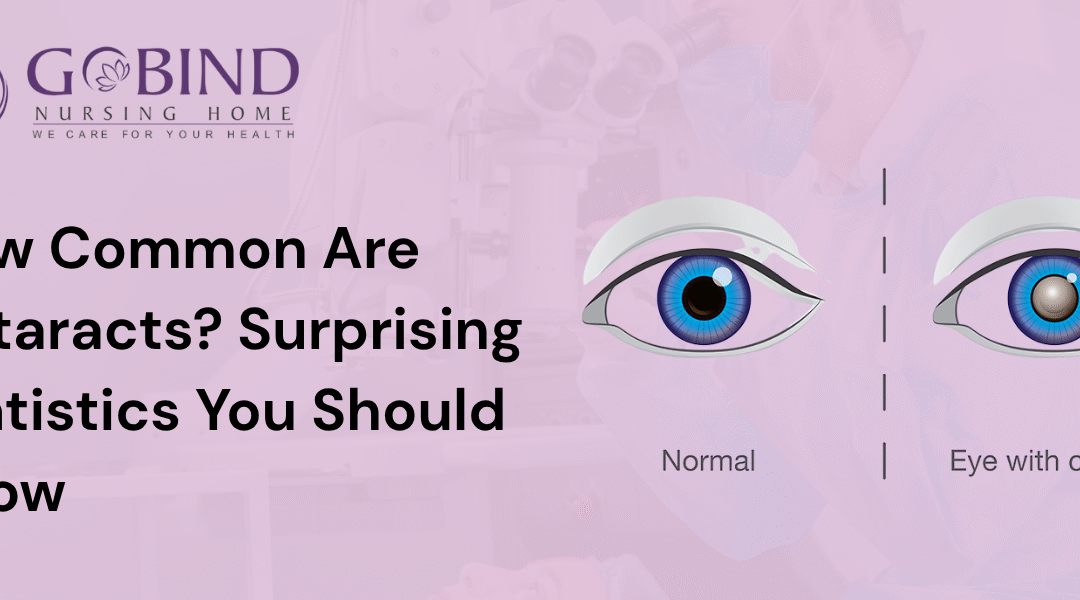Cataracts are one of the most common eye conditions affecting millions worldwide. Yet awareness about their prevalence, symptoms, and timely treatment remains low. Cataracts can develop gradually without causing major discomfort in the early stages, but if left untreated, they can lead to permanent vision loss.
The good news? Cataracts are 100% treatable, and modern surgery can fully restore visual clarity. To help you better understand this condition, this article explores how common cataracts are, globally and in India, who is at risk, and why early treatment matters.
How Common Are Cataracts Worldwide?
As life expectancy increases, cataracts are becoming even more widespread. According to the World Health Organization (WHO):
- Cataracts are the leading cause of blindness worldwide
- Over 65 million people have vision impairment due to cataracts
- Nearly 50% of global blindness is caused by untreated cataracts
- About 1 in every 5 people aged 50+ is affected
Additionally, experts predict the number of cataract cases may double by 2050 due to aging populations.
This highlights the need for awareness, prevention, and early medical evaluation.

Cataract Statistics in India
India has one of the highest cataract burdens globally due to its large elderly population.
| Statistic | Data |
| People living with cataract blindness | ~12 million |
| Adults aged 60+ affected | 70–80% |
| Annual new cataract cases | 3 million+ |
| Cataract surgeries per year | 6–7 million |
India performs the maximum cataract surgeries in the world, yet vision loss still remains high due to:
- Delayed diagnosis
- Lack of awareness
- Fear about surgery
- Belief that cataracts must “fully mature”
Timely treatment can prevent most cataract blindness.
What Causes Cataracts?
The eye’s lens becomes cloudy due to protein changes inside it. Though age is the biggest factor, several risks can speed up cataract development:
Major Risk Factors
- Ageing (most common trigger)
- Family history/genetics
- Diabetes and metabolic disorders
- Prolonged unprotected UV exposure
- Smoking and heavy alcohol use
- Eye trauma or previous surgeries
- Long-term steroid medication
- Poor nutrition — lack of antioxidants

According to Dr. Bindiya Dhupper, “Every patient’s cataract develops differently, which is why eye checkups after age 40 are critical for early detection.”
Symptoms of Cataracts You Should Not Ignore
Cataracts usually start slowly and worsen with time. Signs include:
- Blurred or cloudy vision
- Difficulty seeing at night (especially while driving)
- Increased sensitivity to bright lights or glare
- Colors appearing dull or yellowish
- Need for brighter light while reading
- Frequent changes in prescription glasses
- Double vision in one eye
- Difficulty recognizing faces from a distance
If you notice any of these symptoms, schedule an evaluation with an ophthalmologist at Gobind Eye care immediately.
Can Cataracts Be Cured Without Surgery?
Many people hope for eye drops or simple remedies — but currently The only effective treatment for cataracts is surgery.
No medication, diet, or exercise can reverse cataract formation.
Modern Cataract Surgery — Safe, Quick & Highly Successful
Today’s technology has made cataract removal extremely advanced and patient-friendly.
Benefits of Modern Surgery:
- Stitch-free
- Blade-free options available (Femtosecond Laser)
- Quick (10–20 minutes)
- Pain-free procedure
- Same-day discharge
- Rapid visual recovery
- Permanent, clear vision with artificial lens (IOL)
During surgery, the clouded natural lens is replaced with a clear, artificial Intraocular Lens that remains effective for life.
When Should You Consider Cataract Surgery?
Earlier, people were advised to wait for cataracts to “ripen,” but medical science has changed.
If cataracts affect daily activities like reading, driving, or mobile usage — it’s time for surgery.
Delaying surgery can:
- Increase risk of complications
- Reduce visual outcomes
- Impact independence and mobility
Cataracts & Other Eye Diseases: A Risky Combination
Cataracts can exist alongside:
- Glaucoma
- Diabetic Retinopathy
- Corneal disorders
- Macular Degeneration
These conditions may worsen vision faster or complicate treatment if diagnosis is delayed.
A comprehensive eye exam ensures:
- Healthy retina
- Normal eye pressure
- Strong cornea
- Better surgical outcomes
Can Cataracts Be Prevented?
Cataracts can’t be fully prevented, but lifestyle changes can delay progression:
| Prevention Method | Benefit |
| Wear UV-protected sunglasses | Blocks harmful light exposure |
| Maintain stable blood sugar | Reduces early cataract risk |
| Stop smoking | Slows lens protein damage |
| Nutritious diet (Vitamins A, C, E, lutein, omega-3) | Improves lens health |
| Regular eye checkups after 40 | Detects early changes |
Small habits today = clear vision for the future.
Conclusion
Cataracts are extremely common and a natural part of aging for most people—but they do not have to lead to vision loss. With the remarkable advances in modern cataract surgery, patients today can enjoy fast recovery and clearer vision than ever before. The key to preserving eyesight is recognizing symptoms early, scheduling regular eye checkups after age 40, and not delaying treatment when cataracts begin to affect daily life.
By increasing awareness, addressing risk factors, and seeking proper medical guidance, cataract-related blindness can be significantly reduced—especially in high-burden countries like India. Your eyes support your independence, confidence, and quality of life, so prioritizing eye health is a lifelong investment.
If you or a loved one is experiencing vision changes, take the first step toward clarity and consult an experienced eye specialist Dr Bindiya Dhupper at Gobind Eye Care. Your vision matters—don’t let cataracts stand in the way of a brighter, clearer future.
For More Info

